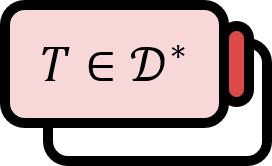Distributions, Generalized Functions
Definition1 2
Let $\Omega \subset \mathbb{R}^{n}$ be an open set. A continuous linear functional $T : \mathcal{D}(\Omega) \to \mathbb{C}$ on the space of test functions is defined as a distribution. That is, a distribution is an element of the dual space of the test function space. Thus
$$ T \in \mathcal{D}^{\ast} $$
and we call $D^{\ast}$ the (Schwartz) distribution space.
Explanation
The name distribution seems to be influenced by the Dirac delta function being designed to represent point masses like mass concentrated at a single point. While it directly translates to distribution, mathematicians call it a distribution. The other name, generalized function, was given because it rigorously defines concepts like the Dirac delta function, which strictly speaking are not functions. An important part in the definition of distributions is the continuity. According to the equivalence conditions for a function to be continuous, the continuity of a distribution $T$ means the following.
$$ \phi_{j} \to \phi \implies T(\phi_{j}) \to T(\phi) $$
However, convergence in the space of test functions is defined a bit specially. So, if we restate the definition of a distribution specifically, it goes as follows.
A functional $T : \mathcal{D}(\Omega) \to \mathbb{C}$ on the space of test functions $\mathcal{D}(\Omega)$ is a distribution if it is linear and continuous.
(a) $T(a\phi + b \psi ) = aT(\phi)+bT(\psi)\quad (\phi,\psi\in \mathcal{D},\ a,b\in\mathbb{C})$
(b) $\phi_{j} \to \phi \text{ in } \mathcal{D} \implies T(\phi_{j}) \to T(\phi)$
Under the condition that the following are satisfied for a sequence of functions $\left\{ \phi_{j} \right\}$ in $\mathcal{D}(\Omega)$, we define $\phi_{j} \to \phi \text{ in } \mathcal{D}$.
(c) There exists $K \Subset \Omega$ that satisfies $\mathrm{supp} (\phi_{j}-\phi) \subset K\quad \forall\ j$.
(d) For each multi-index $\alpha$, $D^{\alpha}\phi_{j}$ uniformly converges to $D^{\alpha} \phi$.
Following the definition of a distribution, the Dirac delta function can be defined as follows.
$$ \begin{align*} \delta_{a} : \mathcal{D} &\to \mathbb{C} \\ \phi &\mapsto \phi (a) \end{align*} $$
